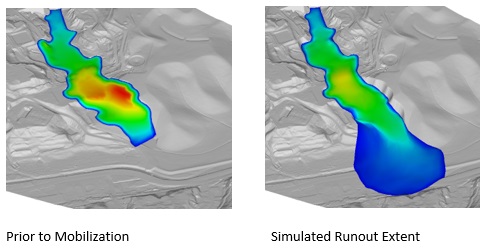Tailings Dam Breach Runout Assessment
April 12, 2019 |
A tailings dam failure is a breach of the dam followed by the uncontrolled release of stored materials that could include supernatant water, fluid and/or tailings solids. The gravity-induced runout of materials is a very dynamic process, and the runout distance is primarily defined by the physics of this motion. Gravity does not act alone, however, because the runout is affected by landform (e.g. slope angles), climate, material properties and the amount of water. During runout, which can happen rapidly in a matter of minutes, the released material deforms spontaneously as it flows. Material parameters during runout are very difficult to measure from case histories, owing to the unpredictable nature of a dam breach event and the typically rapid runout process.
Tailings dam failures can be caused by, but not limited to:
- slope failure due to inadequate characterization of foundations or QA/QC of fills;
- piping failure due to inadequate design or QA/QC of filters;
- overtopping failure due to inadequate water balance and water management;
- a seismic or static event that triggers liquefaction of the impounded tailings deposit;
- major surface erosion, especially at the toe;
- tailings dam design, tailings geotechnical properties, operations, etc.
Tailings dam breach assessment
Tailings dam breach runout assessment provides a basis for evaluating the potential incremental downstream impacts in the event of a tailings dam breach, and for developing emergency planning and response. At a high level, a tailings dam breach assessment should capture the following three steps:
- failure mechanism
- dam breach
- post-dam breach
While the state of practice for dam breach analysis of water retention dams is mature, it is still in its infancy for tailings dams. For a typical tailings storage facility with three physical phases (water, fluid tailings and tailings solids) there are currently no numerical modelling tools available that can model all three phases simultaneously. Assumptions and simplifications need to be made for a reasonable runout assessment from a tailings dam breach. The fundamental difficulty is the phase transition between the solid and fluidized states (and vice versa).

MADflow
MADflow is a numerical modelling software program developed in 2000 by Dr. Joanna Chen, a Senior Geotechnical Engineer at KCB, and her Ph.D. supervisor Dr. C.F. Lee. Originally, it was developed for mobility analysis of debris flows, flowslides and avalanches. MADflow is a quasi-3D (depth averaged) finite element program coded with commonly used rheologic models. It can incorporate failure mechanisms and material properties, complicated 3D terrain, and entrainment of material in the flow path. The program has been calibrated with various field case histories and laboratory experiments on debris flows, flowslides, avalanches and tailings flow failures which have been published in major international geotechnical journals (see the references list below).
The program was recently enhanced for the specific class of inactive/closed tailings storage facilities, where there are little to no permanent or sustained free water ponds, and where the phreatic surface has dropped significantly since operations ceased. The enhanced program is now capable of modeling a two-layered soil system, where the upper layer is unsaturated and non-liquefiable/non-flowable and the bottom layer is liquefiable/flowable. A water-based model is not applicable for estimating the runout extent of this specific class of tailings storage facilities.
KCB has performed tailings runout assessments using MADflow, including for inactive/closed tailings storage facilities, thickened mill sands, and subaqueous liquefied tailings. Efforts are underway to further enhance the program towards a more sophisticated modelling of tailings runout that incorporates all three phases.

Chen, H. and Lee, C.F. 2000. “Numerical Simulation of Debris Flows”. Canadian Geotechnical Journal. 37: 146-160.
Chen, H. and Lee, C.F. 2002. “Runout Analysis of Slurry Flows with Bingham Model”. ASCE, Journal of Geotechnical and Geoenvironmental Engineering. 128: 1032-1042.
Chen, H. and Lee, C.F. 2003. “A Dynamic Model for Rainfall-induced Landslides on Natural Slopes”, Geomorphology. 51: 269-288.
Crosta, GB, Chen, H and Lee, CF. “Replay of the 1987 Val Pola Landslide, Italian Alps”. Geomorphology 60: 127-146, 2004.
Chen, H., Crosta, G.B. and Lee, C.F. 2006. “Erosion Effect on Runout of Fast landslides, Debris Flows and Avalanches: A Numerical Investigation”. Géotechnique. 56(5): 305-322.
Crosta, GB, Chen, H and Frattini, P. “Forecast Hazard Scenarios and Evaluate Countermeasure Efficiency for Large Debris Avalanches”. J. Engineering Geology 83: 236-253, 2006.
Chen, H. and Becker, D. 2014. “Dam Breach Tailings Runout Analysis”. Proceedings of Canadian Dam Association 2014 Annual Conference, Banff, Alberta, Oct. 4-9, 2014.
Disclaimer
This Klohn Crippen Berger Ltd. (KCB) blog post is for general information only and does not constitute professional engineering, geoscience or environmental advice. No user should act on the basis of any KCB blog post without obtaining professional advice specific to their situation or project.
